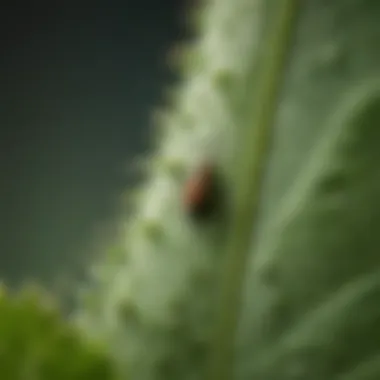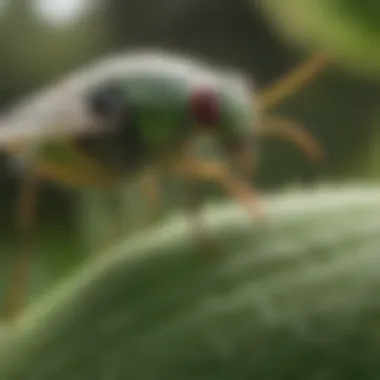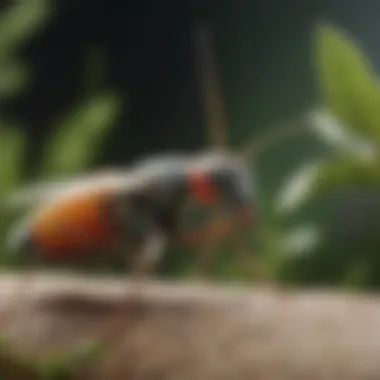Effective Strategies for Removing Aphids from Plants


Intro
Aphids are notorious pests that can wreak havoc on both ornamental and edible plants. Their ability to reproduce rapidly makes them a persistent problem for gardeners. Understanding aphids more deeply is necessary for effective control. Not only are they a direct threat due to their feeding on plant sap, but they also transmit various plant viruses. This section provides key insights into their biology, behavior, and role in the ecosystem. By exploring these aspects, gardeners can formulate effective strategies to manage aphids in their plants.
Animal Overview
Common Names
Aphids are commonly referred to as greenflies or plant lice. They come in different colors, including green, black, and yellow, depending on their species.
Scientific Classification
Aphids belong to the family Aphididae, which falls under the order Hemiptera. They are small sap-sucking insects that exhibit diverse characteristics.
Geographic Range
Aphids can be found worldwide. They thrive in various environments, from gardens to agricultural fields, making them easily accessible to many plants.
Behavior and Social Structure
Social Behavior
Aphids exhibit interesting social behaviors, including the formation of colonies. They are usually found in large groups on the same plant, allowing for efficient feeding and protection from predators.
Communication
These insects communicate mainly through chemical signals, which they produce to alert others in the colony about danger. This chemical communication plays a vital role in their social structure and colony dynamics.
Mating and Reproduction
Reproduction in aphids can be asexual or sexual, depending on environmental conditions. They often reproduce rapidly, especially during favorable weather, leading to population explosions. Eggs are laid in winter, which hatch in spring, contributing to the growth of colonies.
Habitat and Ecosystem
Natural Habitat
Aphids prefer soft, tender plant tissues, which provide ample food. They often inhabit gardens, forests, and agricultural areas, adapting well to cultivated plants.
Food Sources and Diet
Aphids primarily feed on plant sap, which is rich in nutrients. Their feeding can weaken plants, leading to stunted growth and other issues.
Role in Ecosystem
Despite being pests, aphids play a role in the ecosystem. They serve as a food source for multiple predators, including ladybugs, lacewings, and various birds. This relationship highlights the importance of maintaining a balanced ecosystem, even while managing pest populations.
Understanding aphid behavior and ecology is essential for effective management and control strategies.
Prologue to Aphids
Aphids are tiny pests that can create significant troubles for plant health. When left unchecked, these insects can cause serious damage to your garden or indoor plants. The introduction section aims to provide a foundational understanding of aphids, their characteristics, and the necessity of addressing infestations promptly. This awareness is crucial for effective management and helps in recognizing signs of aphid presence.
Understanding Aphids
Aphids belong to the family Aphididae and are classified as soft-bodied insects. They vary in color, typically displaying shades of green, black, or yellow. These insects have a unique ability to reproduce rapidly, making them a constant threat to plant life. Adult aphids can be found in groups, often clustered on new growth, undersides of leaves, or along stems.
Aphids feed on plant sap, which is a nutritious fluid rich in sugars and proteins. Their feeding process not only weakens plants, but it can also lead to the curling of leaves, yellowing foliage, and even plant death. Understanding their behavior is key to effective removal strategies.
Aphids also secrete a sticky substance called honeydew, which can attract other pests like ants and lead to further issues such as sooty mold. Thus, it is essential to be vigilant and proactive.


The Importance of Addressing Aphid Infestations
Ignoring aphid infestations can result in a cascade of negative effects on your plants. Early intervention is critical to prevent extensive damage. Here are some key reasons for addressing aphid problems immediately:
- Plant Health: Aphids can significantly weaken plants, affecting their growth and fruit production.
- Economic Losses: For commercial growers, high populations of aphids can lead to substantial financial losses due to reduced crop yields.
- Ecosystem Impact: Aphids can disrupt local ecosystems by attracting other pests and harming beneficial insects.
"Prompt action against aphids not only preserves plant integrity but also maintains ecological balance in your garden."
In summary, understanding aphids and the urgency to manage them is essential for any gardener or plant enthusiast. This knowledge sets the stage for exploring effective strategies to eliminate these pests, which will be elaborated on in the sections that follow.
Identifying Aphids
Identifying aphids is an essential step in managing these pests effectively. Recognizing aphid presence early can help prevent extensive damage to plants. Distinctive features and visible signs play a crucial role in this identification process. By becoming familiar with these characteristics, gardeners can implement control measures before aphid populations grow out of hand.
Physical Characteristics
Aphids are small insects, typically measuring between one to ten millimeters in length. Their bodies are usually pear-shaped and might be green, black, brown, or even pinkish. This color variation depends on the species. Aphids possess soft bodies and have long, slender mouthparts called stylets. These allow them to pierce plant tissues and extract sap efficiently. Moreover, their legs and antennae are relatively long, and they have two characteristic tubes protruding from their abdomen, known as cornicles.
Identifying the specific aphid species can be beneficial in applying targeted control measures. There are hundreds of aphid species, but the most common ones you might encounter in gardens include the green peach aphid, the black bean aphid, and the cotton aphid. Take note of their color, body shape, and size when observing your plants. Recognizing these traits can greatly enhance your ability to manage aphid populations.
Signs of Infestation
When it comes to signs of infestation, aphids can leave various indicators on your plants. One of the most common signs is the presence of clustered aphids on new growth, especially on tender leaves and flower buds. These clusters can lead to wilting and curling of leaves, causing significant stress to the plants.
Another common sign is the sticky substance known as honeydew. This substance is excreted by aphids as they feed on plant sap and can attract other pests like ants. Additionally, honeydew can promote the growth of sooty mold, a black fungal growth that can hinder photosynthesis.
Other symptoms of aphid infestations include yellowing or stippling of leaves, which occurs when aphids withdraw nutrients from the plant. A closer inspection may also reveal tiny, dark dots on leaf surfaces, which are aphid excrement. Recognizing these indicators early can save plants from further damage and help you implement effective control strategies.
It is vital to check your plants regularly, especially during the growing season, to catch aphid infestations in their early stages.
Natural Removal Methods
Natural removal methods for aphid control are vital for protecting your plants without using harsh chemicals. These methods can be highly effective and often have the added benefit of being environmentally friendly. Understanding these techniques allows gardeners to manage aphid populations while maintaining the health of their plants and the ecosystem.
Water Spray Technique
The water spray technique is one of the simplest methods to remove aphids. Using a strong stream of water can dislodge these pests from your plants. This method works best for small infestations and is most effective early in the day to avoid harming the plants.
- Procedure: Use a hose or spray bottle to direct a vigorous stream of water at the affected areas. Focus on the undersides of leaves, where aphids often congregate.
- Frequency: Repeat this process every few days until the infestation is controlled.
This method not only removes aphids effectively but also helps to rinse away sticky honeydew produced by these insects which can lead to sooty mold.
Soap Solutions
Soap solutions provide another effective natural remedy for aphid removal. Commercial insecticidal soaps are available, but you can also create a homemade soap solution.
- Homemade Recipe: Mix 1 to 2 tablespoons of liquid dish soap in a quart of water. Ensure the soap is free from additives, as these can be harmful to plants.
- Application: Spray the solution directly onto aphid-infested plants. Thoroughly cover both sides of the leaves to maximize effectiveness.
- Considerations: It’s advisable to test the solution on a small area of the plant first, as some sensitive plants can react negatively to soap.
Soap works by suffocating aphids, making it a highly effective method without leaving harmful residues.
Essential Oils
Essential oils can also serve as a potent natural treatment for aphids. Oils such as peppermint, neem, and rosemary are known for their insect-repelling properties.
- Usage: Dilute 10 to 20 drops of essential oil in a quart of water. Adding a few drops of dish soap can help the solution stick to plants.
- Application Method: Spray the solution onto the affected areas of your plants. Ensure even coverage for the best results.
These oils not only deter aphids, but they can also enhance the overall aroma of your garden, offering an additional benefit.
Effective natural methods not only target aphids but also contribute to a balanced ecosystem, promoting beneficial insect populations.


Biological Control Agents
Biological control agents are crucial in managing aphid populations without resorting to chemical pesticides. These agents leverage the inherent behaviors of natural predators and parasites that target aphids, presenting a sustainable alternative for gardeners and plant enthusiasts.
By employing biological control, one can reduce the reliance on synthetic chemicals, which can have adverse effects on non-target species and the ecosystem at large. This method supports ecological balance and promotes healthy plant communities. Below we will explore two prominent categories of biological control agents: predatory insects and parasitic wasps.
Predatory Insects
Predatory insects such as ladybugs, lacewings, and hoverfly larvae are effective against aphids. They actively seek out and consume these pests, significantly decreasing their numbers. Here are key aspects of using predatory insects:
- Natural Predators: Ladybugs, for instance, are voracious consumers of aphids. An adult ladybug can eat up to 50 aphids in a single day.
- Habitat Enhancement: To attract these beneficial insects, it's advisable to create a conducive habitat. Planting flowers like dill, fennel, or marigolds can offer nectar and pollen, which help sustain these predators.
- Release Timing: Timing the release of predatory insects during peak aphid infestations can maximize effectiveness. Understanding the lifecycle and habits of these beneficial bugs can make a significant difference in your approach.
Parasitic Wasps
Parasitic wasps are another powerful biological control method. These tiny wasps lay their eggs inside aphids, which leads to the aphids' eventual demise. This method offers a long-term solution to aphid control. Consider the following:
- Specificity: Many parasitic wasps are species-specific, targeting only aphids. This precision means that they do not pose a threat to other insects, making them a favored option for organic gardeners.
- Lifecycle Benefits: The lifecycle of parasitic wasps helps sustain their population. As they reproduce, they can continue to manage aphid populations over time without human intervention.
- Releases Strategy: Similar to predatory insects, releasing parasitic wasps at the right time ensures a greater impact. Monitoring aphid populations helps in timing these releases effectively.
Biological control agents not only reduce aphid numbers but also promote biodiversity and ecosystem health.
Utilizing biological control agents is an environmentally friendly strategy that leverages natural relationships within ecosystems to manage pests effectively. By understanding and incorporating these methods in your gardening practices, you can achieve sustainable aphid control while fostering a thriving ecosystem.
Chemical Treatment Options
Chemical treatment options are essential for managing aphid infestations effectively. While natural methods are often preferred for those looking to maintain an organic garden, there are situations where chemical options may be necessary. These options can provide immediate relief from aphids, particularly in severe infestations. Understanding the different types of chemical treatments and their application is crucial for anyone looking to protect their plants efficiently.
Insecticidal Soaps
Insecticidal soaps are a popular choice for controlling aphids due to their effectiveness and relatively low toxicity. They work by disrupting the cell membranes of soft-bodied insects like aphids, leading to dehydration and death. Here are some key points regarding insecticidal soaps:
- Composition: These soaps are made from natural plant oils and fats, making them a safer option for use around pets and humans.
- Application: For best results, apply insecticidal soap directly onto the aphids, ensuring thorough coverage of the affected plant parts. Reapplication may be necessary after rain or watering, as they can wash off easily.
- Effectiveness: While effective, insecticidal soaps work best on young, active aphids. Therefore, early detection and timely application are vital.
- Considerations: Always test a small area of the plant before wider application to check for any adverse reactions, especially on sensitive plant species.
Systemic Pesticides
Systemic pesticides offer a different approach to aphid control. These chemicals are absorbed by the plant and transported through its tissues. As a result, when aphids feed on the plant, they ingest the pesticide, leading to their elimination. Important aspects of systemic pesticides include:
- Long-lasting Protection: Once absorbed, these pesticides can provide extended protection against future infestations, making them a suitable choice for long-term management.
- Targeted Action: Systemic pesticides specifically target sap-feeding insects, providing a lethal effect to aphids while minimizing harm to beneficial insects, provided they are applied correctly.
- Application Methods: These pesticides can be applied as granules, sprays, or soil soaked solutions. The choice of method depends on the product and the severity of the infestation.
- Safety Measures: When using systemic pesticides, it is important to follow the manufacturer's instructions carefully regarding timing and application rates to ensure safety and effectiveness.
Preventative Measures
Preventative measures play a crucial role in managing aphid populations and safeguarding plant health. By adopting specific strategies, one can significantly reduce the chances of infestation. Understanding these methods not only protects individual plants but also contributes to the overall health of the garden ecosystem. Prevention is often more effective than dealing with an established infestation, both economically and environmentally.
Maintaining Plant Health
Maintaining the health of plants is fundamental in preventing aphid infestations. Healthy plants can withstand stressors better, making them less attractive to aphids. Here are some key aspects:
- Proper Nutrition: Ensure your plants have adequate nutrients. Fertile soil can foster resilience against pests. Utilizing compost or organic fertilizers can enhance soil quality.
- Water Management: Avoid both overwatering and underwatering. Consistent moisture helps plants stay strong, while excess water may lead to root stress, making them vulnerable to pests.
- Regular Pruning: Removing dead or infected leaves helps reduce hiding places for aphids and enhances air circulation.
- Sunlight Exposure: Ensure plants receive adequate sunlight. Shade can create an environment conducive to aphid populations.
By focusing on these elements, gardeners can create a robust foundation for their plants, thereby minimizing the risk of aphids settling in.
Companion Planting Strategies
Companion planting is a proactive approach that involves growing certain plants together to deter pests like aphids. This strategy can create a balanced ecosystem and enhance plant growth. Here are several effective companion planting techniques:
- Planting Marigolds: These flowers are known to repel aphids and other pests. They can create a protective barrier around more vulnerable plants.
- Using Garlic and Chives: Both garlic and chives have strong scents that aphids dislike. Incorporating these plants nearby can help in managing aphid populations.
- Nasturtiums as Decoys: Nasturtiums can serve as 'trap plants'. Aphids are attracted to them, which diverts them from more valuable crops.
Incorporating these companion plants offers a natural defense system. This strategy can lead not only to improved pest control but also to enhanced biodiversity in the garden.
By implementing preventative measures, gardeners can create a thriving environment that deters aphids before they become a problem.


Long-Term Management of Aphids
Long-term management of aphids is a crucial aspect of maintaining healthy plants in any garden. Rather than solely focusing on immediate removal methods, an integrated approach helps mitigate future infestations while considering the overall health of the ecosystem. By establishing a proactive management plan, gardeners can better protect their plants from the persistent threat of aphids.
Effective long-term strategies can provide numerous benefits. These include reducing the reliance on chemical treatments, promoting beneficial insect populations, and encouraging a balanced ecosystem. By understanding the life cycle of aphids and their interactions within the environment, one can implement more effective preventive measures.
Several considerations should guide long-term aphid management. It is essential to monitor plant health regularly, conduct inspections for early signs of infestations, and understand which plants are more susceptible to aphid damage. This knowledge allows gardeners to establish practices that lead to healthy plant growth, thereby reducing vulnerability to pests.
Monitoring Techniques
Monitoring techniques play a vital role in effective aphid management over time. Regular plant inspections help identify any early infestations before they escalate into significant problems. By keeping a close eye on your plants, you can quickly react to any signs of aphid activity.
A few practical methods for monitoring include:
- Visual Inspections: Examine the undersides of leaves and new growth, where aphids often congregate. This can help in spotting them before they multiply.
- Sticky Traps: Utilize yellow sticky traps to catch flying aphids. This method provides insight into the population levels and helps keep track of their numbers.
- Regular Surveys: Create a schedule for checking plants, perhaps weekly. This habitual inspection promotes consistency and helps identify patterns of infestation.
Combining Methods for Effectiveness
Combining multiple methods for aphid control can significantly increase their effectiveness. A multi-faceted approach allows for the integration of natural remedies, biological controls, and, if necessary, targeted chemical treatments.
- Natural and Biological Controls: Using beneficial insects such as ladybugs or lacewings provides a natural predation method. Simultaneously, natural remedies like neem oil can deter aphids while being less harsh on the environment.
- Cultural Practices: Altering cultural practices, such as plant spacing, can enhance air circulation and reduce humidity, which helps lower stressors that may attract aphids.
- Chemical Options: If necessary, utilize specific chemical treatments responsibly. It is important to target the treatment to minimize disruption to beneficial organisms.
By addressing aphid control from multiple angles, gardeners can create a more resilient system that withstands ongoing infestations while promoting overall plant vitality. A comprehensive strategy enhances long-term health and minimizes the impact of these pervasive pests.
The Role of Ecosystems in Aphid Control
Aphids are not merely isolated pests; they are part of a larger ecological system. Understanding their role within ecosystems can significantly enhance our strategies for management and removal. Ecosystem dynamics play a vital role in regulating aphid populations. Utilizing these interactions can lead to more effective, sustainable outcomes in aphid control.
Understanding Interactions within Ecosystems
Aphids interact with a variety of organisms in their environment, including plants, predators, and other beneficial insects. These interactions form an intricate web that influences aphid populations.
Their primary food source, plant sap, not only provides nourishment for aphids but also impacts the health of host plants. Plants that exhibit stress, either from environmental factors or pest damage, may become more attractive to aphids. When plants are healthy and robust, they are less likely to be infested.
Key Interactions to Consider:
- Predators: Natural enemies such as ladybugs and lacewings feed on aphids. By attracting these beneficial insects to your garden, you can create a natural form of control.
- Parasitoids: Certain wasps lay eggs inside aphids. When these eggs hatch, the larvae consume the aphid from the inside. This biological control can significantly reduce aphid numbers.
- Plant Companions: Some plants repel aphids naturally or attract their predators. Incorporating these companion plants can help manage aphid populations.
By fostering a balanced ecosystem, gardeners can minimize the need for chemical treatments and build resilience against aphid outbreaks.
Restoring Balance in Plant Communities
Restoring balance within plant communities is essential for reducing aphid infestations. A diverse plant environment encourages beneficial insect populations that keep aphids in check. A single crop or plant variety might attract more pests, creating a conducive environment for aphids to thrive.
Strategies for Balancing Plant Communities:
- Diversity: Introduce a variety of plant species. This can disrupt aphid-host dynamics and attract beneficial insects.
- Plant Health: Healthy plants are less susceptible to aphid infestations. Regular maintenance, appropriate watering, and targeted fertilization can contribute to plant vigor.
- Ecosystem Management: Observe and understand the local ecosystems. Recognize patterns of pest populations and beneficial insects. This knowledge can guide effective interventions.
By focusing on ecosystem dynamics and restoring the natural balance, aphid control becomes a sustainable practice rather than a temporary fix. This not only enhances the environment but also promotes the overall health of the garden.
Finale
The conclusion section of this article emphasizes the critical aspects of effective aphid removal strategies. Understanding how to combat aphids is essential for anyone who engages with plants, whether for gardening, education, or professional purposes. Aphid infestations, if left unchecked, can lead to considerable damage to plants, affecting their growth and vitality.
Recap of Effective Strategies
In summary, the article presented various methods to tackle aphid infestations. These include:
- Natural removal methods such as water sprays, soap solutions, and essential oils.
- Biological control agents like predatory insects and parasitic wasps that can help manage aphid populations.
- Chemical treatments, which encompass products like insecticidal soaps and systemic pesticides.
- Preventative measures that focus on maintaining overall plant health and implementing companion planting strategies.
- Long-term management techniques, emphasizing monitoring and combination of various methods to enhance effectiveness.
Understanding these techniques allows plant caretakers to make informed decisions based on their specific situations.
Final Thoughts on Prevention and Management
As we conclude, it is worth noting that prevention plays a fundamental role in managing aphids. By focusing on maintaining plant health and recognizing early signs of infestation, one can minimize the likelihood of severe outbreaks. It is vital to remember that integrating multiple strategies often yields the best results. A combination of natural, biological, and chemical methods can create a more robust defense against aphids. By being proactive and knowledgeable about the options available, plant enthusiasts can preserve their plants and create a thriving garden environment.
Effective aphid management is not just about removal; it is about creating a balanced ecosystem where plants can flourish without the threat of pests.







